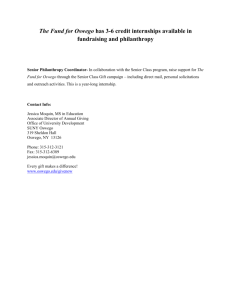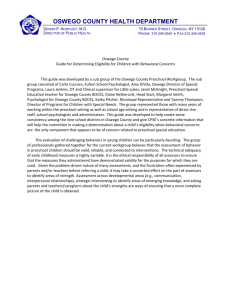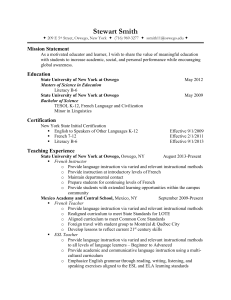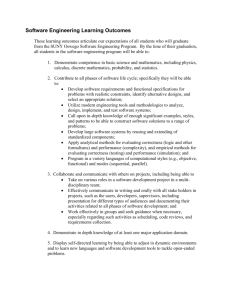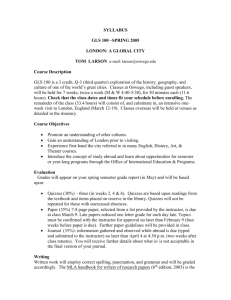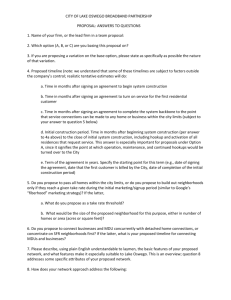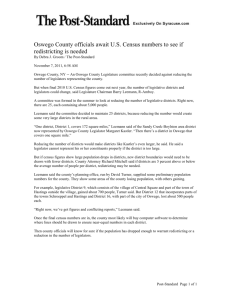1 Teachers on Assignment: Staff Development From the Inside
advertisement
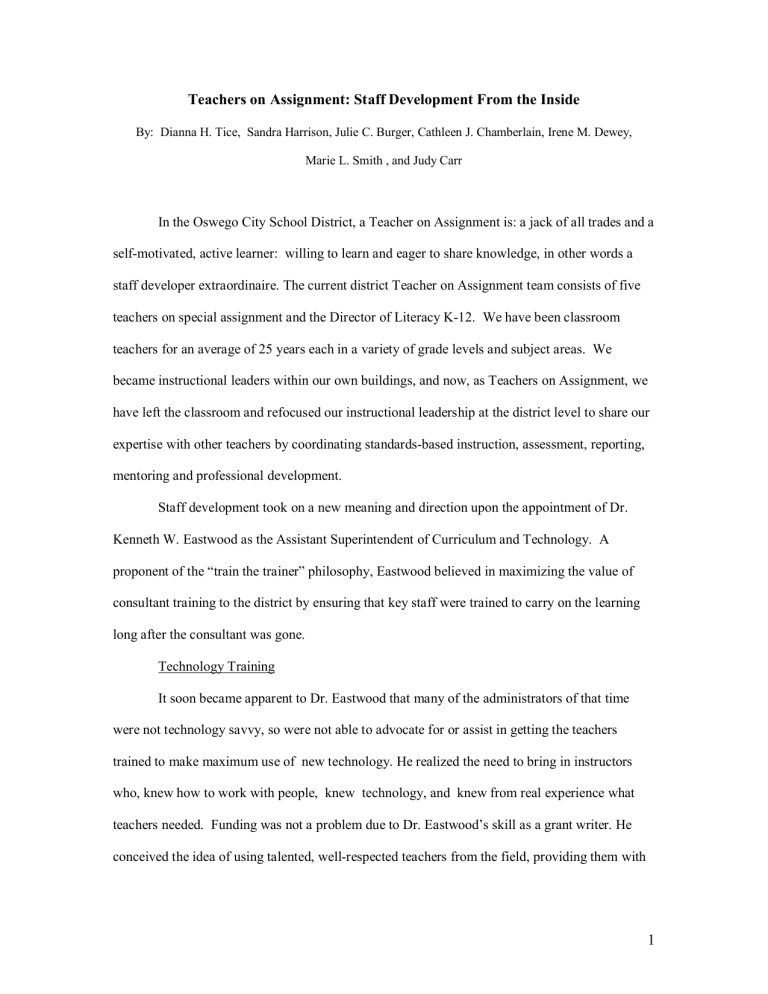
Teachers on Assignment: Staff Development From the Inside By: Dianna H. Tice, Sandra Harrison, Julie C. Burger, Cathleen J. Chamberlain, Irene M. Dewey, Marie L. Smith , and Judy Carr In the Oswego City School District, a Teacher on Assignment is: a jack of all trades and a self-motivated, active learner: willing to learn and eager to share knowledge, in other words a staff developer extraordinaire. The current district Teacher on Assignment team consists of five teachers on special assignment and the Director of Literacy K-12. We have been classroom teachers for an average of 25 years each in a variety of grade levels and subject areas. We became instructional leaders within our own buildings, and now, as Teachers on Assignment, we have left the classroom and refocused our instructional leadership at the district level to share our expertise with other teachers by coordinating standards-based instruction, assessment, reporting, mentoring and professional development. Staff development took on a new meaning and direction upon the appointment of Dr. Kenneth W. Eastwood as the Assistant Superintendent of Curriculum and Technology. A proponent of the “train the trainer” philosophy, Eastwood believed in maximizing the value of consultant training to the district by ensuring that key staff were trained to carry on the learning long after the consultant was gone. Technology Training It soon became apparent to Dr. Eastwood that many of the administrators of that time were not technology savvy, so were not able to advocate for or assist in getting the teachers trained to make maximum use of new technology. He realized the need to bring in instructors who, knew how to work with people, knew technology, and knew from real experience what teachers needed. Funding was not a problem due to Dr. Eastwood’s skill as a grant writer. He conceived the idea of using talented, well-respected teachers from the field, providing them with 1 training, and empowering them to do the job well. The Teacher on Assignment model was the result. Nine years ago, Cathy Chamberlain, an established second grade teacher, and Daniel Harmony, a veteran high school social studies teacher, became the first Teachers on Assignment in the Oswego City School District. Dr. Eastwood remembers that at the time he offered her the position as a staff developer, Cathy told him, “I don’t know a lot about computers.” However, her reputation as a life long learner and her interest in technology were the only prerequisites necessary. Dan was added as a Teacher on Assignment for Technology because he brought finance and administrative knowledge to the table. Cathy researched staff development files from the past fifteen years. She found, at a time when there were 440 professional staff in the district, that over a five year period of time while it appeared that there were 318 participating in-service, realistically the same core group of 15 people participated in all the various offerings. During this time, the technology courses had been taught by “techies”, people who knew computers well, but often lacked the ability to simplify the computer jargon for less technology savvy people and made teachers uncomfortable. The computer skills were taught in isolation and there was no integration piece to show teachers how it could work in the classroom. Since classes were solely technology based, there was no application of learning. Her research also showed that during this time many courses offered were cancelled due to lack of participation. As a Teacher on Assignment, Cathy created courses for technological novices and helped to integrate technology into all of our schools. According to Cathy Chamberlain, an important benefit of the Teacher on Assignment concept was “having someone in the district that teachers could contact any time they got stuck. If you have people who are constantly hitting a brick wall when they try things, they aren’t going to use the technology and will soon revert back to the old way of doing things.” With a Teacher on Assignment, they could call for immediate help almost anytime. 2 Carefully listening to teachers concerns about their lack of time to meet with other teachers at their grade level to share ideas inspired the introduction of yet another new component of the in-service program. One way of sharing the teacher talent clearly evident in the district was to begin posting these technology integration projects online for district-wide sharing at http://www.oswego.org . This created a win-win situation for both the district and the teachers. Teachers could now begin sharing their ideas and projects through an easy to use online searchable database. More recently a peer review process has been added to assure that only high quality examples are placed on the website. Coordinating Curriculum When Dr. Eastwood became the Superintendent of the Oswego City School District in 2001, he returned to the Teacher on Assignment model to address the curricular needs of the district. Specific academic needs were identified, and teachers were handpicked by the superintendent to focus on these needs in the newly expanded role of Teacher on Assignment. The job required that they be creative, show initiative , and possess the desire to pass on learning. In the fall of 2001, Julie Burger, an innovative second grade teacher, was hired as an Elementary Curriculum Coordinator to focus on math, science, and social studies; Sandra Harrison, a highly regarded third and fourth grade teacher, became the Writing Coordinator for grades K-6. Dr. Eastwood brought together the newly formed Teacher on Assignment team, which included Irene Dewey, the Director of Literacy, and Cathy Chamberlain, to define the critical needs of the district and the role of Teachers On Assignment. The district had many wonderful programs, but the need existed to bring them together to create a learner centered standards based system (insert figure 1: Oswego City School District Standards-Based Learning graphic). To provide the team with training and on-going support, consultants from the Center for Curriculum Renewal were hired to work as coaches. Professional development, standards-based reporting and assessment, instructional strategies, and mentoring were explored, defined, and developed together, then were implemented in the district by the Teachers on Assignment. 3 Ground work began to develop a K-6 standards based reporting system. The New York State Standards were delineated down to the core curriculum for grades pre-K to 8 to align classroom practice and assessment with the state standards and assessments. After the Teacher on Assignment team worked with elementary teachers for a year, they realized that middle and high school connections were necessary. In the fall of 2002, Dianna Tice, a respected eighth grade English teacher and a member of the middle school leadership team, joined the team of Teachers on Assignment focusing on English Language Arts in grades 58. This brought the district’s curriculum and professional development work to the secondary level, and involved the team leaders from the middle school and high school in the work with the Center for Curriculum Renewal to improve students learning in relation to the standards The team worked together in a year long effort with elementary teachers to develop standards-based report cards for grades K-6, with an electronic grade book and plan book, and handbooks for parents and teachers. (insert figure 2: Oswego City School District StandardsBased Report Card example) The work progressed in delineating the NYS core curriculum for grades 9-12 in preparation for their work on a secondary level standards-based report card over the next two years. Professional Development Our team was given the charge of broadening the district staff development program. As a result, we provide teachers with professional development opportunities and training in district policies and procedures, literacy instruction, New York State Standards, integrating technology in the classroom, curriculum development, classroom management, and research based instructional strategies. Curriculum based courses are always grounded in research for best practices. We focus on trying to find ways to help teachers save time, impact their instructional practices, and enrich teaching and learning. We act as researchers, helping teachers bring best practices and current educational research into their classrooms. The in-service courses are designed to model the 4 instructional strategies that the teachers can then apply in their classrooms. These classes also act as a vehicle for communication and reflection among teachers. New York State has mandated that mentoring be in place in all districts by February of 2004, so the Teachers on Assignment researched, designed and now coordinate Oswego’s mentor training, which includes cognitive coaching and reflective listening, as part of the professional development plan. The district team is currently working on a staff development continuum to address the needs of all stakeholder groups and will continue to provide a strategic offering of courses to help all teachers become more familiar with standards based instruction to maximize student achievement, and integrate technology into their classroom instruction (insert figure 3 – Oswego City School District Professional Development Continuum here). The full range of Oswego City School District courses can be viewed at http://oswego.org/pdfs/courses.pdf . While at times the job of teacher on assignment feels like treading water while holding a brick, it is very rewarding. What keeps us here is the opportunity to have impact on a large scale and with many teachers. This allows us to reach so many more students than we could have before. In the classroom, teachers are so involved in the instructional piece that they don’t have the time for all of the professional reading and research they would like to do. The team approach allows us to become a community of learners and leaders. We divide the work, become experts, use each other as resources, and continue the cycle of learning with teachers across our district.. Key Learnings Not long ago, we went on a retreat together, and one of our newer members shared, “Sometimes I feel like an imposter. I don’t know enough to do the job well.” This led to every one of us acknowledging our own feelings of uncertainty at various times. No one of us knows everything, but as a group, we have a wide range of expertise. Interestingly, the more we have become a team, the more we have been able to divide up responsibilities and get the work done in 5 an efficient manner. When one of us is unavailable, others are able to cover and the work gets done. Over the years, we have discovered the importance of working closely with the team of district principals through regular leadership seminars we engage in together. We are much more likely now to ask for help when we need it, to set priorities, and to say “no” to work that isn’t the most critical in taking us to our primary goal: improving the experience and performance of all Oswego students by being a solid support for teachers and administrators throughout the district. _______________________________________________________________________ Authors: Dianna H. Tice is a Teacher on Assignment for ELA grades 5 – 8 in the Oswego City School District. She taught English at the middle level for twenty-eight years and has served as Oswego Middle School English Department Team Leader for three years. She also teaches literacy inservice and coordinates a Summer Writing Institute for teachers between the district and the University of New Hampshire Sandra Harrison is a Teacher on Assignment as a Writing Coordinator for the Oswego City School District. She taught at the elementary level for twenty-five years. She teaches in-service mentoring courses and coordinates a Summer Writing Institute for teachers between the district and the University of New Hampshire Julie C. Burger is a Teacher on Assignment as an Elementary Curriculum Coordinator for the Oswego City School District. She taught at the elementary level for eighteen years. She teaches in-service mentoring and technology courses. 6 Cathleen J. Chamberlain is a Teacher on Assignment as a Technology Integration Specialist for the Oswego City School District. She has been involved in elementary education for twenty years. Along with teaching technology integration courses, she has authored three books for teachers in the use of Microsoft Office Programs. Irene M. Dewey is the Director of Literacy K-12 for the Oswego City School District. She has taught reading for twenty-five years, the last ten as a Reading Recovery Teacher. Irene teaches in-service courses in the area of literacy. Marie L. Smith is a Teacher on Assignment as a Technology Integration Specialist in the Oswego City School District. She taught at the elementary level for fifteen years and served as a department chairperson for three years in the Red Creek Central School District. Judy Carr is associate professor in the Educational Leadership Department at the University of South Florida and a consultant with the Center for Curriculum Renewal in Sarasota, Florida and Swanton, Vermont. 7 Figure 1: Oswego City School District Standards-Based Learning Graphic 8 Figure 2: the Oswego City School District Standards-Based Report Card example Oswego City School District Grade 4 Standards-Based Report Card Name: School: Class: Student ID: School Year: Teacher: English Language Arts Grade Effort Instructional Reading Level Comments: Quarter Social Studies Grade Effort Comments: Quarter Math Grade Effort Instructional Level Comments: Quarter Science/Health Grade Effort Comments: Quarter Technology Grade Effort Comments: Quarter Attendance Absent Tardy Art Grade Effort Comments: 3 Meeting Expectations Q4 Quarter X X 2 Approaching Proficiency O = Outstanding S = Satisfactory NI = Needs Improvement Effort Key Grade placement ____ for 2003-2004 Teacher assignment will be mailed to you. Oswego City School District Q3 Quarter X X X X Music Grade Effort Comments: 4 Exceeding Expectations Q2 Responsibilities of the Learner * use effort key Strives for personal best Demonstrates active listening Follows directions Works cooperatively Works independently Is organized and prepared Completes class work on time Completes and returns homework and/or materials on time Respects diversity, rights, feelings, and properties of others Is polite in speech and manner Asks for help when needed Handles conflict appropriately Demonstrates self-control Accepts responsibility for own behaviors Participates in discussions Engages in activities Comments: Physical Education Grade Effort Comments: Grade Key Q1 U = Unsatisfactory Quarter X X Quarter X X X X 1 Not Proficient NA = Not Applicable Figure 3 – Focus OCSD Professional Development Continuum Induction Year 2 *Getting here *Staying *Improving Student Achievement *Getting here *Staying *Improving Student Achievement See mentor calendar See mentor calendar Year 3 & 4 Experienced Teachers *Improving Student Achievement *Working With Colleagues *Setting Individual Professional Development Goals Related to Categories in this Chart and any other areas needed to stay current and effectively improve student achievement *Designing standards-based units of study *Creating an effective year-long plan for teaching and assessing the standards for which one is responsible *Making strong connections within and across disciplines *Employing an effective system for selecting exemplars of student work in *Using a standardsbased curriculum for all students that is rigorous, challenging and relevant Teacher Leaders/ Mentors *Supporting Others’ Efforts to Improve Student Achievement Administrators Teachers on Assignment *Setting Individual Professional Development Goals Related to Creating Systems to Support Improved Student Achievement Setting Individual Goals Related to Providing Professional Development, Curriculum, and Technology Supports to Teachers and Administrators Improving Student Achievement *Having familiarity with standards and their role and impact on teaching/learning *Understanding what a stand-based classroom looks like and using this knowledge in interactions with teachers *Providing equitable and prompt access for all students to accurate materials, current resources, appropriate for learning goals related to standards and quality instruction *Understanding systems and how they change and impact all stakeholders *Having familiarity with standards across all areas Delivery Approaches Management Policies/Procedure s Standards, Curriculum Design, and Resources Oswego City School District *Designing standardsbased lessons *Knowing the content and skills that support the standards * Selecting classroom materials (textbooks, trade books, videos, software, etc.) to enhance student learning in relation to standards * Selecting which standards will focus instruction Induction Year 2 Year 3 & 4 Experienced Teachers Teacher Leaders/ Mentors Administrators Teachers on Assignment *Understanding district assessments and how to analyze and use data. *Understanding and supporting standardsbased assessment, grading, and reporting *Understand district assessments and how to analyze and use data *Understand district assessments and how to analyze and use data relation to standards *Having students use clear criteria and exemplars to assess their work Instruction Literacy Across the Curriculum Assessment, Grading, Reporting *Using strategies of brain-based learning *Using Performance By Design Strategies Understanding ELA Best Practices *Reporting on student learning in relation to standards * Using strategies appropriate for standards-based grading * Using technology to assess and report on student learning Oswego City School District *Using valid and reliable assessment tools to make decisions about student learning in relation to standards. *Engaging students in active learning, building on prior knowledge and experiences, and developing conceptual and procedural understanding, along with student independence *Providing instruction that uses time effectively and flexibly to achieve learning goals related to the standards Using & Integrating ELA Best Practices *Using multiple classroom products and performances to give students feedback about their learning in relation to standards *Using assessment data to improve instruction *Selecting and using scoring guides (rubrics, checklists, answer keys) based on standards. *Using projects and assignments that require students to integrate and apply their learning in meaningful contexts and to reflect on what they have learned *Providing equitable and prompt access for all students to accurate materials and current resources appropriate for learning goals related to the standards. *Designing effective systems for monitoring, assessing, and supporting student progress and success in achieving standards *Using assessment to inform instruction and make needed changes in programs. Induction Year 2 Year 3 & 4 Experienced Teachers Working with Colleagues See Mentor Calendar See Mentor Calendar *Using guidelines to collaboratively examine student work *Engaging in study groups on topics related to s-b reform *Working with departments, teams and committees *Observing and giving feedback to colleagues on their practices *Engaging in study groups on topics related to standards-based reform Technology Support * Using technology to support instruction *Using technology to support and communicate about s-b curriculum, instruction, assessment, and reporting *Using technology to support and communicate about s-b curriculum, instruction, assessment, and reporting *Using technology to support and communicate about s-b curriculum, instruction, assessment, and reporting Oswego City School District Teacher Leaders/ Mentors *Mentoring new teachers *Leading study groups on topics related to standards based reform *Taking a leadership role in departments, teams, and committees *Working with school and district leadership to implement standards *Maintaining professional ethics: confidentiality, trustworthiness, and professional *Using technology to support and communicate about standards-based curriculum, instruction, assessment, and reporting Administrators Teachers on Assignment *Working with colleagues, staff, and the community to implement standards *Leading study groups, governance committees, and faculty meetings. *Leading departments, teams, committees, and courses *Maintaining professional ethics: confidentiality, trustworthiness, and professionalism *Using technology to support and communicate about standards-based curriculum, instruction, assessment, and reporting *Using technology to support and communicate about standardsbased curriculum, instruction, assessment, and reporting
